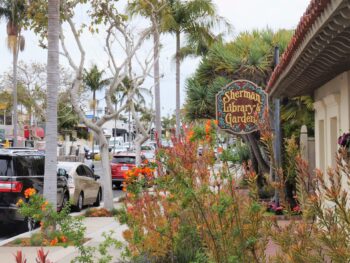The following article is copyrighted by The Dallas Morning News and scheduled to publish at a later date.
Washington, D.C. has a new garden, a sheltered space set apart six stories high, a sanctuary in the skyline of the city. These days, most urban rooftops are gardened for produce, providing caches of cabbage to cucumbers, tomatoes to turnips in raised beds. Instead, this new garden offers the simple pleasures of refreshment and rest, a place of pause, portraying the pastoral. It is the rooftop terrace at the Museum of the Bible, newly opened this November a few blocks south of the U.S. Capital.
Ironically, in a museum about a book, Bible verses are not depicted on signage, nor are there any words graphically displayed in the garden. Yet a perceptive Bible reader will quickly become aware of the centrality of one large tree in the garden’s design, resonating the words of Genesis:
in the middle of the garden he placed the tree of life
Genesis 2:9 NLT
It is a reference returned to often in Scripture, reverberant in the metaphor of a person
whose delight is in the law of the Lord…that person is like a tree, planted by streams of water
Psalm 1:3 NIV
The tree of life appears at the end of the Bible’s last book, Revelation, as well—
on each side of the river stood the tree of life
Revelation 22:2 NIV
—Genesis to Revelation, from “tree to shining tree,” so to speak, to parody the expansive description of our nation’s landscape in the hymn, “America the Beautiful.”
Bible Garden Design

Working with a relatively small space (while the entire roof is vegetative to meet LEED standards, only a protected portion is publicly accessible) and the windswept challenges of the urban location, landscape architect Doug Hays, FASLA, Principal with Michael Vergason Landscape Architects, Ltd., wanted to impart the overarching continuity of the tree of life, the garden element prominent in the Bible from beginning to end.
“Biblically, the history of man begins and ends in a garden,” says Hays. “Both of these gardens are defined by the central elements of water and the tree of life, which establishes common ground and dawns a desire to draw near to God. It speaks to the soul’s yearning to be restored. ”
The tree of life is most often described as planted by a river, thus Hays selected a riparian species, Wisconsin weeping willow, Salix x pendulina ‘Wender’, as the arboreal focal point of the garden space. Willow’s graceful, gentle boughs communicate an approachable, welcoming beauty, symbolically speaking the quenching invitation, “let the one who is thirsty come,” at the end of the Revelation chapter (v. 17).
Hays then captured the tree-water connection, the concurrence of the tree of life being planted along a river in Genesis and the river of life in Revelation, echoed in the refreshing water description of Psalm 23.
The Lord is my shepherd, I lack nothing. He makes me lie down in green pastures, he leads me beside quiet waters, he refreshes my soul.
Psalm 23:1-3 NIV
Beyond the tree, a cascading wall of water descends into a reflection pool, depicting both the vitality of moving water, as known in rivers, and the stillness of calm, current-less water bodies, “quiet waters,” that refresh the soul.
Adding deeper dimension, the water wall, sparkling in its splash and bubble, hints at the shining, jeweled walls surrounding the river and the tree of life of the New Jerusalem. The water wall encloses the southern side of the garden, giving visitors a special, translucent view of the garden through glistening droplets.
Flowers of the Field

No garden is complete without flowers, and Hays called on the “flowers of the field” to enhance the pastoral setting with blooming delight.
And why do you worry about clothes? See how the flowers of the field grow. They do not labor or spin. Yet I tell you that not even Solomon in all his splendor was dressed like one of these. If that is how God clothes the grass of the field, which is here today and tomorrow is thrown into the fire, will he not much more clothe you—you of little faith? So do not worry
Matthew 6:28-31 NIV
Naturally, the elevated urban climate contrasts greatly with that of the mild Mediterranean Bible lands; Hays worked to find cold-hardy substitutes for holy land wildflowers that will survive Washington’s winter exposure. Atlas Fescue, an African pasture grass, along with Prairie Dropseed, a tufted ornamental grass, are ground covers for the garden beds surrounding the terrace, dotted spring and fall with a succession of wild flower-like blooms: anemones, bluebells, coreopsis, gaura, hellebores, lilies, tulips, windflowers.
This would have been the setting for many of Jesus’ open-field teachings, a small vignette in the Bible Garden to acknowledge the expansive reach of his words—words destined to inspire the tremendous museum below.
The grass withers and the flowers fade, but the word of our God stands forever.
Isaiah 40:8 NLT
Museum of the Bible opens November 17, 2017, and free access to the Bible Garden is included with admission. Visit www.museumofthebible.org for more information.
Learn more about the work of Doug Hays, FASLA at www.vergason.net
For more on planting willow trees in your home Bible garden, see our Plant Guide:
gardenndelight.wpengine.com/plant-guide/willow/
Photos Credits: ©Museum of the Bible
Sketch detail of the weeping willow “tree of life” central to the Bible Garden at Museum of the Bible
Workers lower ‘Tree of Life’ by crane into the Bible Garden
Complete conceptual rendering of the Bible Garden in the design phase by Michael Vergason Landscape Architects Ltd.
“Flowers of the field” depicted in this photo from Galilee, “Anemonies in Bloom,” ©2010 Creative Commons Israel Tourism Galilee is a large region in northern Israel which is traditionally divided into Upper Galilee, Lower Galilee and Western Galilee . The picture shows a field of wild anemonies. Photo by Itamar Grinberg.
“America the Beautiful” by Katharine Lee Bates, 1893 visit hymnary.org/text/o_beautiful_for_spacious_skies















